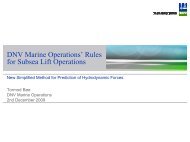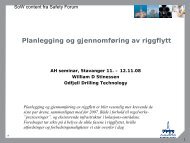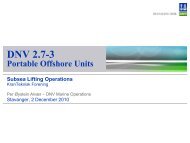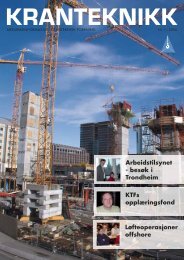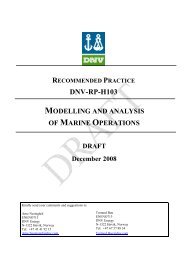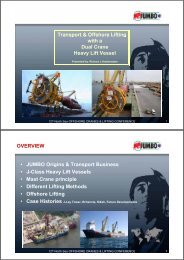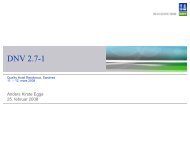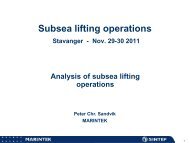Crane & Lifting standardisation
Crane & Lifting standardisation
Crane & Lifting standardisation
- No tags were found...
Create successful ePaper yourself
Turn your PDF publications into a flip-book with our unique Google optimized e-Paper software.
Index• NORSOK Standards (NORWAY) http://www.standard.no/en/sectors/Petroleum/• ISO standard Offshorecranes• OGP <strong>Lifting</strong> and hoisting reccommended practice. Report no.376− http://www.ogp.org.uk/publications/safety-committee/lifting-and-hoistingsafety-recommended-practice/• DNV Joint Industry Project - Sub sea lifting appliances2Classification: Internal 2013-04-09
Barriers for safe lifting operationsOperationTechnical causesMaintenanceExpert control•Management•Risk assesment/planningNORSOK R-003/005•Competence•Behavior•Enterprise of competence •Prosedures•Competence of inspector•Risc based control programInherent safedesignNORSOK R-002Safe workingarea•Hazard list•FMECA•RCM based maintenanceprogram•Maintenance procedure manual•Competence•View to landing area•Large enough landing area•No obstructions in lifting routeKL-Simkran-03-Presentasjon 8 Rev:2 06.01.2012
NORSOK R-002 Rev. 2<strong>Lifting</strong> equipmentClassification: Internal 2012-02-20
NORSOK R-002 <strong>Lifting</strong> equipment Rev.2• Validity – Norway - Petroleum installations at sea and at land + MODU’s ?• Refered to as the recognised standard for lifting equipment, in the petroleumbusiness in Norway, by the Petroleum Safety Authority (PSA).• Revision started October 2007 – Published September 2012• Promotes the principle of inherent design• CE marking, certificate of compliance etc. is not a part of this standard.• Refers to existing standards where available, mainly EN Standards.• Additional requirements raise the safety level at the equipment.• The work group consists basically of the «3 parties» (employer, employee andauthorities) and a consultant (Det Norske Veritas), that prepared the first draft.• One of the most comprehensive standards for lifting equipment.5Classification: Internal
R-002 Rev. 2 Structure(Informative)Main part (standard)K: High risk applicationsJ. <strong>Lifting</strong> lugs and shackles1. Scope2. References3. Definitions4. Generalsafety requirements5.CommonrequirementsE. Elevators and liftsI.Elastic pennant, MOB boatH. FoundationsG. <strong>Crane</strong>sF. Portable unitsAnnexesD. <strong>Lifting</strong> equipment, drillingC. <strong>Lifting</strong> accessoriesB. Material handlingA. Launching and recoveryappliances(Normative)6 - Classification: Internal
SummaryCha.4Overall HSE requirementsCha.5References to international A and B levelstandards.AnnexesReferences to international standards at Clevel, with adaptions to the Petroleumindustry. And/or new requirements wherestandards are missing7 - Classification: Internal
•What is new ?8Classification: Internal
Main Standard• No single technical failure shall result in an unacceptable risk• Hazard identification, safety integration and inherent design according to ISO 12100• Complex lifting appliances (offshore cranes, BOP cranes, draw works, launching appliances, tower cranes, mobile cranes etc.)− FMECA, RCM• Structural strength – according to EN 13001 series, known break down sequence• Control systems EN ISO 13849-1 (Performance level)• Quality assurance (ISO 9000)• High risk Applications. <strong>Lifting</strong> of load above pressurised hydrocarbons, lifting of persons and dangerous loads.• Emergency lowering for all power driven lifting appliances.• Emergency Operation System (EOS) for lifting of persons• Design to avoid falling objects.• Instruction for use (EN 12644-1 og EN 13155)9Classification: Internal
Annex A Launching and recovery appliances• Functional requirement from DNV standard for free fall lifeboats + SOLAS andMaritime Authority• Relevant load conditions and load combinations (γ n = 1.5 for lifting persons, training, launching in 16m Hs (Lifeboat), test loads, environmental loads, retrieval mode, secondary means of launching etc.)• Relevant SOLAS tests and NORSOK tests of prototype, FAT and installation• Safety measures in line with Machinery Directive for lifting appliances, when peopleare lifted or lowered (in boat).• Lifeboats launched by falls and winch: «Pull and go» lowering, automatic release atsea, manual back up system to avoid re entry and high dynamic factors.• Strength calculations of MOB boat release mechanism and the elastic pendantwhen launched by offshore crane10Classification: Internal
Annex B Material handling principles• Global design of installations and plants tofacilitate safe material handling – during entireliftetime• Design of plant shall facilitate lifting operationsduring operation of plant• Prioritised philosophy for Material handling(fork lift truck, elevators, lorry mountedcranes, mobile cranes)• Permanent arrangement or a description forlifting, for equipment weighing more than 25kg – differentiated according to maintenanceinterval.• <strong>Lifting</strong> zone map for the installation• Clear view from main cranes operator stationto main landing areas• Requirements for Material handlingphilosophy and Material handling plan.11Classification: Internal 2012-02-20
Annex C <strong>Lifting</strong> accessories (G11)• Special designed equipment for lifting at drill floor is defined as lifting equipment.• Design shall also ensure that these lifting accessories is safe to use (Ref.Machinery directive)• Requirements and description of load testing for each type of lifting accessories• Hinged mechanical joining devices shall not be used12Classification: Internal
Annex D <strong>Lifting</strong> equipment in drilling area• Defines the equipment at drill floor that is lifting equipment, and which one is drillingequipment.• Functional requirements from NORSOK D-001 Drilling equipment• Design according to DNV OS-E101 “Drilling plant”, API standards and the generalrequirements in ch. 4 and 5 in R-002.13Classification: Internal
Annex E Lifts• Refers to EN 81 standards• Collects additional requirements inother NORSOK standards (S and C) inAnnex E• The lift shall have a totally enclosed liftwell.• Possibility for the passengers in the liftto evacuate, with out help from outside,in an emergency situation at theinstallation.• The lift chair shall be connected to theinstallation’s PA system and telephonesystem14Classification: Internal
Annex F Portable units• Reference to DNV 2.7.1 (EN 12079), DNV 2.7.2 and partly DNV 2.7.3• New design calculations for lifted object (load)• Stacking pins and protruding parts that can snag to structure at boat or other loadsare not allowed on portable units.• <strong>Lifting</strong> sets to be of material, grade 8015Classification: Internal
Annex G <strong>Crane</strong>s• Refers to EN standards from TC147• General requirements for Emergency operation system for Offshore cranes• New additional requirements to raise safety level at offshore cranes (data recorder,wireless access to control system, rigging sensor, position of emergency stop and MOPS, speeds, anti collision system,interface to safety systems at installation)• Requirements for load chart for launching of MOB boat by offshore crane• Power operated lifting appliances shall have emergency stop and a main switch• Manual chain hoists shall have an overload device and double brake activatormechanism16Classification: Internal
Annex H Foundations and suspension• Monorails, lifting lugs, sheave brackets and foundations for lifting appliances• Detailed design recommendationsAnnex I Selection of elastic pennant (Informative)• Calculation example• Optimization of SF and length to achieve acceptable dynamic factor (below 3)Annex J <strong>Lifting</strong> lugs and mating shackles (Informative)• 3 types of design• <strong>Lifting</strong> lugs to match standard shackles (EN 13889 and US Fed. RR-C-271)17Classification: Internal
Annex K High risk applications (Informative)• Recommendations for lifting appliances used inhigh risk applications (risk of major accident)• Class 1: Considerable consequences orpotential loss of lives in the vicinity of the liftingoperation• Class 2: Very serious consequences orpotential loss of lives at the whole installation• Duplicating of components is the preferredmeasure for mechanisms and suspensions• Increased risk coefficient for foundations,superstructures etc. γ n =1,5 for Class 1, γ n = 2for class 2• Control systems to have performance level d ore for class 1 and e for class 2• Special requirements for use and maintenance18Classification: Internal 2012-02-20
NORSOK R-003Revisjon 3. 2013Classification: Internal 2012-10-31
Revision 3 of NORSOK – R003, 2013• Status April 2013• The NORSOK Specialist group (EG-RL) is a steering committee for the revision• Work group 1 is revising the general requirements in the standard− Group leader is Oddvar Øvestad from Talisman• Work group 2 is revising the training and competence regime− Group leader is Arild Kasin from Statoil• Revision started January 2013• Planned hearing of revised standard 01.01.201420Classification: Internal 2012-10-31
Work group 1 Revision of standardWork program:• <strong>Lifting</strong> operations in Drilling & Well/ Sub sea lifting/ Construction lifts/ Rigging I structure• Certification of Special designed lifting accessories in D&W• Risk assessment and planning• <strong>Lifting</strong> above pressurised hydrocarbon systems and critical equipment• Role descriptions/ manning of lifting operations• Manual guiding of load, hook and use of tag line• Blind zones /crowded load deck/ danger of entangling load to boat• Sub sea lifts/ construction lifts• Certification of launching and recovery appliances for life saving equipment• Communication/ use of hand signals• Adjustments to NORSOK R-002/ NORSOK R-005/ NWEA• Human factors• Specific comments from the companies21Classification: Internal 2012-10-31
Work group 2Revision of competence requirementsWork program:• Revision of the training standards (Implement NORSOK R003/005)• Requirements for a Craftsman Certificate for operators of offshorecranes• Try to establish an independent examiner arrangement• Try to establish an independent quality check of training companies and theirtraining courses22Classification: Internal 2012-10-31
New ISO standard forOffshorecranesClassification: Internal 2012-11-19
ISO/AWI 18467 Offshore <strong>Crane</strong>s-new standard• A voting in ISO, autumn 2012, gave positive result, to start the development of anew ISO standard for offshore cranes• Standard Norge has the secretary for the work group• A specialist (Nils Justad) has developed a «draft» for the standarden.• The draft is based on API 2C, EN-13852-1 and ISO 12100• The work group will be organised under TC96 – Sub Committee 8• First work group meeting is 6 of June• Planned to be published 1 of October 2015Clas 24
New revision of OGP <strong>Lifting</strong> &Hoisting RPReport. 376Classification: Internal 2012-11-19
New revision 2012/2013• OGP = International Association of Oil & Gas producers• RP 376 developed in 2006• Revision 2 started in July 2012• Revision will try to maintain the goals from the 2006 edition− RP made basically for the management− Describes main areas that must be in place for safe lifting operations− 2-5 essential principles with in each area− Complementary details for each area• A few more areas than the 2006 edition+ details are proposed.• Chairman is Kevin Boyle BP UK, deputy Walter Rawlings Shell US26Classification: Internal 2012-11-19
New Table of contentsSection 2Management SystemSection 3DesignSection 4PrepareSection 5CategoriseSection 6AssessSection 7PlanSection 8AuthoriseSection 9ExecuteSection 10Learn27Classification: Internal 2012-11-19
DNV Joint Industry ProjectSub sea lifting appliancesDNV-RP-H201Classification: Internal 2012-11-19
DNV JIP Sub sea lifting appliancesDNV-RP-H201 DRAFT.• Table of content:1. General2. Structure and dynamics3. Control/Power systems4. Fabrication, inspection, certification and maintenance5. Operation6. Heave compensation systemsHearing started this weekPublication is planned for July 201329Classification: Internal 2013-04-09
Thank you !Presentation titlePresenters namePresenters titleE-mail address ……@statoil.comTel: +4700000000www.statoil.com30Classification: Internal 2013-04-09



